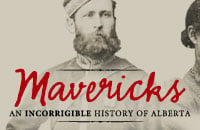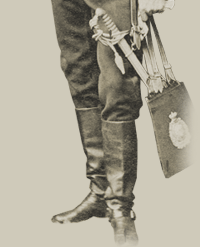

 |
|
GlossaryGlossaries have been created to provide the definition for words specific to each theme area. It is suggested that students review the glossaries before they examine a specific theme area. For example, the Ranching Glossary contains many terms such as "greenhorn," "heifer," or "wrangler," that only a rancher or cowboy might know. Barrack: A building or group of buildings used to house military personnel and soldiers. Battalion: An army unit usually consisting of a headquarters and three or more companies. Bison: A very large, bovine mammal having large forequarters, a shaggy mane, and a massive head with short curved horns. Often mistaken with the term buffalo. Blackfoot Confederacy: A First Nations alliance that includes the Kainai (Blood), the Siksika (Blackfoot), and the Piikani (Peigan) tribes. Blood Tribe: Also called the Kainai, the name means "Many Chiefs." The Kainai/Blood are members of the Blackfoot Confederacy, an alliance that also includes the Siksika (Blackfoot), the Piikani (Peigan), and the Blackfeet. Boer War: A war fought from 1899 to 1902 between the Boer governments and Great Britain in South Africa. The war was over the sovereignty and commercial rights in these lands and ended with British victory. Bright's disease: A disease marked by an inflammation of the kidney. Buckskin: Soft, yellowish leather having a suede finish made from deerskins. Buffalo: Applied to the North American mammal; bison is the correct name of the animal (see Bison). Commissioner: A governmental official or administrator in charge of a department or military group. Discharge: To release a soldier from duty. First Nations: A Canadian term for an organized aboriginal group or community. First Nations provides a respectful alternative to Indian, a term that may be taken offensively. Gold Rush: A large movement of people to an area where gold has been discovered. Hoedown: A Western social gathering at which music and dancing often take place. Insubordination: The act of an inferior military officer deliberately disobeying a lawful order from a superior officer. Magistrate: A minor official with the power to administer and enforce law within a limited jurisdiction. Marquee: A large and often sumptuous tent, often with open sides. Maverick: There are two main definitions.
Minstrel: An entertainer who traveled from place to place, usually singing folk songs and reciting poetry. Mobile forge: A movable furnace or hearth where metals are heated and shaped into tools or weapons. Mortar: A high-angle cannon with a short barrel that fires shells at high elevations for a short range. Mutiny: Open rebellion of military personnel against superior officers. North-West Rebellion (1885): A provisional government was proclaimed in the West by Louis Riel in March, 1885, especially because of broken promises by the Federal Government to the First Nations and Metis groups. It was eventually overthrown with the capture of its capital, Batoche, on 12 May 1885. Riel was taken prisoner and later hanged for treason. NWMP: The North-West Mounted Police was created in 1873 by the federal government. Their mission was to bring order to the frontier, encourage settlement, and establish Canadian authority in what is now Western Canada. Piikani/Peigan: One member tribe of the Blackfoot Confederacy, an alliance that also includes the Siksika (Blackfoot), the Kainai (Blood), and the Blackfeet tribes. Provisional Government: A government in power or serving only for the time being or for the short term. RCMP: In 1919, the RNWMP became the Royal Canadian Mounted Police due to the need for a permanent federal police force for Canada. Recruit: A new member of a military force, usually of the lowest rank. Red River cart: A small horse-drawn cart with three-foot solid wheels cut from large trees that could carry up to 450 pounds. Re-enlist: To re-enter a military force. Regiment: A military unit of ground troops composed of at least two battalions. RNWMP: In 1904, King Edward VII decreed that the name of the NWMP be changed to include the "Royal" in recognition of its excellent service to Canada. Sovereignty: Complete autonomy and self-government by a nation. Treaty: A formal agreement between two or more groups or states, usually in reference to peace or trade. Union Jack flag: The national flag of the United Kingdom (or Great Britain). |
![]()
Mavericks Home
| Student Resources Home |
Teacher Resources
Contact
| Site Map | Credits
© Copyright Glenbow Museum, 2006. All Rights Reserved
